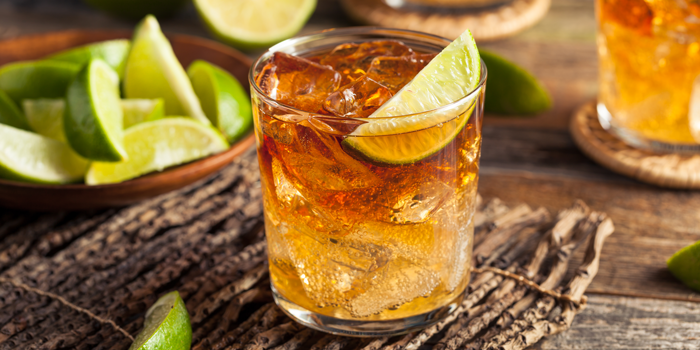
Pronounce it: rhum
Rum is a type of spirit based on sugar cane. First produced in the 1600s on slave plantations in the Caribbean, rum can be made directly from sugar-cane juice or from molasses, a rich and dark byproduct of sugar production that gives an earthier background flavour.
In both cases, the liquid is allowed to ferment and is then distilled to draw off the alcohol, which is then diluted with water, as is the case with all other spirits. This spirit is naturally clear and both colour and flavour are added by storing in barrels, although the addition of caramel to imitate their effects is common in lesser brands.
Rums of all kinds are increasingly popular in cocktails with appealing Caribbean, Hawaiian and other exotic associations. Rum and Coca-Cola is the best known, popularised around the world by the Andrew Sisters’ Second World War song of the same name.
Availability
Widely available in an ever-increasing variety of styles, strengths and flavours.
Choose the best
A newly extensive choice of styles and costs plus the astonishing modern popularity of cocktails means that rum has lost its rather seedy reputation as a spirit associated with teenagers, rowdy sailors and street festivals. Today very sophisticated varieties are sold in growing volumes – some superior, well-aged rums can retail for over £100 a bottle.
When buying rum it’s first necessary to decide if you want to drink with mixers or to drink straight, with or without the addition of a little ice and water. After that, there is no unifying international categorisation of rum. Either price or experience are your best guides.
The rums from Caribbean islands, once part of the British Empire, are generally the darkest available and their flavours have clear reminders of the molasses from which they are made.
French Caribbean rums are sold as ‘rhum’. Most are ‘rhum agricole’ which signifies they have been made from sugar cane juice and thus have a lighter but still vegetal echo of their origins.
Rum from Spanish-speaking regions, sold as ‘ron’ or ‘ron anejo’ are generally thought to be smoother tasting than others of the Caribbean or adjacent South American countries.
White rum is simply a spirit that is young and fresh and that has not been coloured by ageing in oak barrels.
Golden rums, rarely made in ex-British regions, are what they seem, neither white nor dark but they often have a more mellow flavour because ageing in bourbon casks adds sweeter, fruity qualities. They can be very expensive.
Each area has different regulations concerning strength and ageing, details of which are usually on the bottle. As with other spirits, rum does not mature further once it is bottled.
Other geographical locations that make rum also do their own thing: in Australia rum is dark, red or white; red rum is overproof i.e. over 40% proof (a 100% proof spirit is actually 50% alcohol, so a 40% spirit means 20% is alcohol, and so on).
Store it
Once opened, the flavour and freshness will deteriorate over time and the finer the quality, the less you want this. Special bottles should be stored well sealed, in a cool and dark place to minimise the effect of air. If you’re a slow drinker of a superior rum, it’s a good idea to decant into a much smaller bottle in which the surface area is as small as possible. That is, it should be able to be filled to the neck.
Cook it
The darker Caribbean rums make a lively and different addition to all kinds of cooking, sweet or savoury. Chicken and tomato stews really come alive, especially when you also add lime. Dark rum makes an excellent addition to barbecue sauces and marinades, again partnered with lime juice and/or zest is probably best. A sprinkle of dark rum and lime over grilled seafood or even stir-fried prawns makes a delicious difference, with or without a touch of sweet chilli sauce, too.
Dark rum is good with all citrus and so perks up marmalade memorably, as it will a tropical fruit salad. But be very abstemious or it will overpower.
Sliced fresh pineapple with a sprinkle of rum plus angostura bitters and/or lime zest is memorably good – even better if grilled and served warm.
White rums are too fragile of flavour to use in cooking but can be used to add a spirituous quality to creamy desserts, including panna cotta, or in jellies that contain such tropical fruits as fresh mango. But remember that pineapple stops gelatines from setting.
Be the first to comment on "Rum"